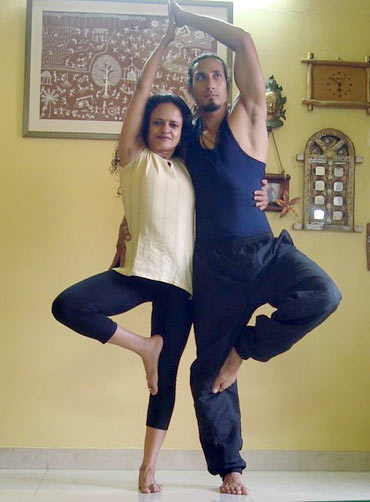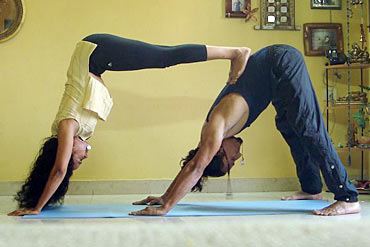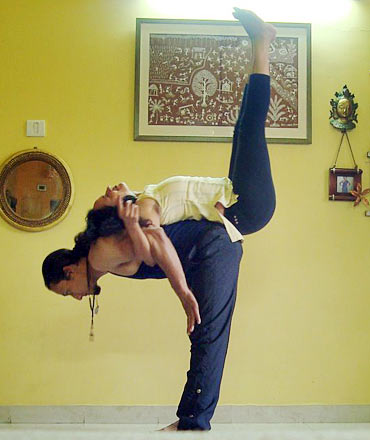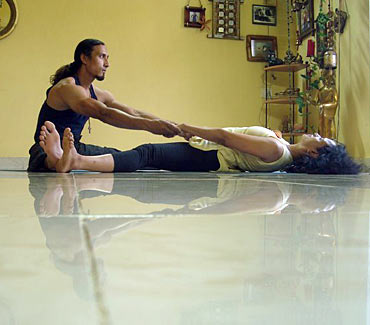Photographs: Jahnavi Sheriff Shameem Akthar
Partner yoga is a powerful concept that has found a new spurt of interest in recent times. One of the reasons could be that practitioners appreciate how it seeks to bind people who are close to each other. This could mean partner yoga tie-ups between a parent and a child, two close friends, two siblings or between lovers or spouses.
Partner yoga also uses the energy of the partner to make a difficult pose very easy. It can take you deeper into a pose than you may dare to while on your own. It also invites a continuous dialogue to ensure that the partners are sharing and not jarring each other's practice. Also it teaches you very elegantly the art of being still and listening, instead of always talking and doing, in a relationship. It takes the theory of a relationship and makes it practical.
Partner yoga works on the ideals of trust, companionship, sharing and communication. And since these are all relevant to the idea of Valentine's Day, we present five great poses that you can practice with your partner.
Intriguingly, it does not matter if the partners are not physically matched in age, height, strength or weight. When the poses are done with technical finesse they can show how two differently oriented individuals can make not just a functional, but a rocking, team!
Shameem Akthar, yoga acharya trained with the international Sivananda Yoga Vedanta Center, with Muay Thai instructor Biki Bora shows you five easy partner poses that may be practiced with someone special.
These poses, though easy to practice, need guidance of a yoga teacher. Attempt them only if you have some yoga practice already on. For more on Shameem's yoga writings and workshops, go to http://jaisivananda.blogspot.com
Eka pada pranamasana (One-legged prayer pose)
Stand beside your partner, so your torsos are touching from the inside. Each of you must bend your outside leg (as shown) at the knee, so the foot of that leg rests on your supporting leg's thigh. Ensure your knees are pointed outward and not tilting in front.
Each of you passes the inner hand around the other's waist, to hold lightly. Each also passes the outer hand overhead as shown to bring the palms together to form a namaste with each other. Hold the pose as long as possible. Switch sides, by turning back, so that both legs are used in the practice.
Adhomukha svansana (downward facing dog pose)
This is also called parvatasana or mountain pose or the inverted V pose.
One partner remains passive in the inverted V, with the legs slightly apart. The active partner moves in front of the passive one, places each foot carefully over the back of the passive partner, as shown.
To do this, stand a few feet in front of the passive partner. Then place both palms flat on the ground. Next, from either the right or the left side of the passive partner, pass each foot over till each is resting on the back of the passive partner. The ball of each foot must be firmly placed to ensure that your balance is firm and both are grounded.
Each partner looks down to ensure that the balance is not compromised. Looking up can make this delicate and complex partnership shaky.
Hold for a few seconds, breathing normally. The active partner first releases the pose by stepping gently on the left/right side of the passive partner, taking one foot off firmly and surely.
Points to note: The distance of the partner decides how intense the pose can be. Being too close can make it difficult for beginners, so keep a distance of about two feet before starting. It is an extremely light pose and no partner will feel any heaviness. However, how you get into the pose and out of it is important not to jar the other person. The passive partner must not move suddenly or will unnerve the active one. So continuous communication is important to do this pose well and with finesse.
Ekapada adhomukha svanasana (One-legged downward dog pose)
Do as the previous pose. Now the active partner must firmly raise one leg in the air, ensuring it is not bent at the knee. Hold for a few seconds. Drop it back gently to the back of the passive partner before repeating with other leg.
Points to note: This is a slightly advanced version and may be attempted only after confidence is gained in the previous pose.
Dwipadasana (Double leg lift)
The passive partner must stand with feet about half a foot apart. The active partner leans back. Both interlock arms at the elbow as shown. Then the passive partner tilts the torso slightly lower, while simultaneously the active partner lifts both legs up in the air. The legs remain aloft for a few seconds. Then as the passive partner straightens back up, the active partner drops legs back to the ground.
Points to note: The height or weight of each partner is not relevant, but the active partner must decide to lift the body lightly. This comes from a shared bond of trust between the partners. Also the passive partner must not bend too much ahead since that will lift the active too high, making the latter nervous. The arm lock must be firm.
The active partner, if short, must stand up on toes before the lift happens to ensure it is smooth. The legs of the passive partner must be far enough apart to ensure he or she is able to bear the weight well. Keeping the legs too close will compromise balance.
Upavista Konasana (Wide spread angle pose)
Sit with legs apart, facing each other. Your hands must be held in front, locked at the wrist to ensure they do not slip when the pose intensifies. One partner's feet will be slightly inside, to form a lock at the ankle. Now inhale. Exhaling, one partner goes as far back as possible, to the ground or almost to it (depending on flexibility).
Inhaling, the partner raises torso back to center, exhaling lowers the head and torso to the ground in front. This is one round. The other partner repeats the forward and backward rocking motion.
Points to note: Do not spread the legs more than you can comfortably. Tilt forward and back only up to capacity.







Comment
article